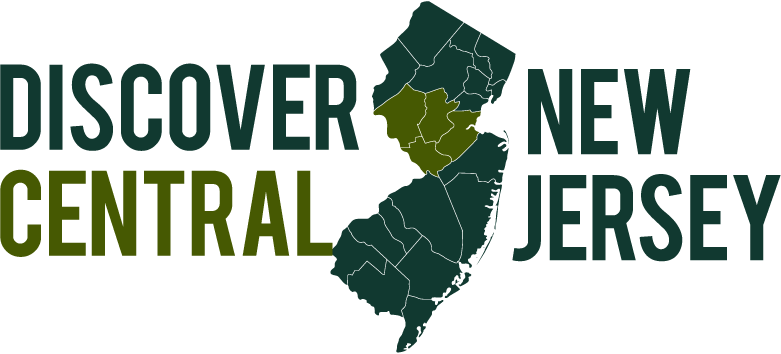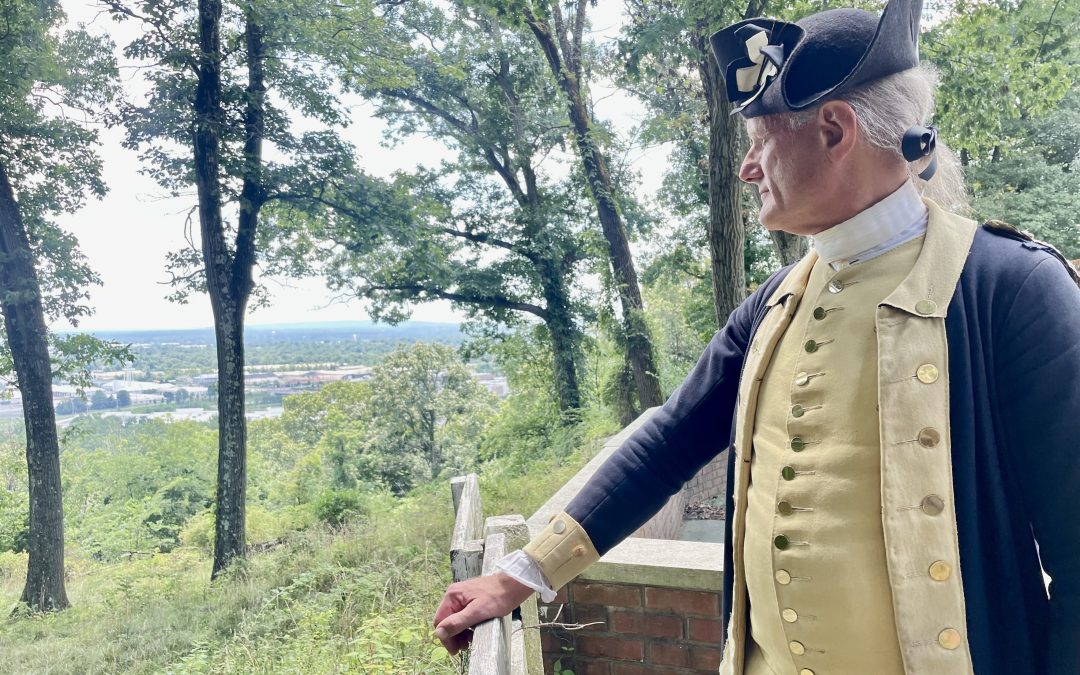A sold-out audience of more than 200 people heard five historians describe crucial events of the American Revolution in the suburban “backyards” of Somerset County residents at the third Middlebrook Symposium held March 15 at Raritan Valley Community College. The symposium included maps that showed where the Continental Army twice encamped between 1777 and 1779, relative to modern-day interstate highways—such as Routes 287, 28, 22, and 18—and provide new perspectives on the strategic importance of these encampments.
An edited video recording of the proceedings is viewable on the Afton streaming platform at a cost of $25 through April 19. Tickets are available at https://heritagetrail.org/.
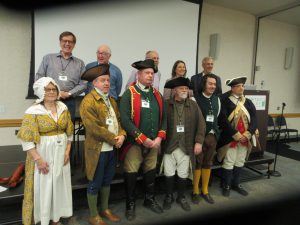
Speakers and reenactors at the 2025 MIddlebrook Symposium.
“The Middlebrook encampments are such a fascinating episode in the history of New Jersey and of the Revolutionary War that have not seen the attention they deserve because [the historic sites] are split up,” said Monmouth University archaeologist Richard Veit. “They are in people’s backyards and pocket parks across Somerset County.”
Dr. Veit showed historic maps overlaid with modern interstate highways that reveal how history happened all around the daily activities of Central New Jerseyans. He also displayed images of bullets, cannonballs, musket pieces, boot buckles, and other artifacts he and his students have found in digs near major highways such as Route 18 and at the Washington Campground in Bridgewater. And he showed high-tech “LiDAR” images that reveal Revolutionary fortifications on the local landscape.
Another presenter, Dr. Michael Beck, expanded on his thesis that Middlebrook was the “center stage” of the entire Revolutionary War, as he asserted at the 2024 symposium, because the natural fortress of the Watchung Hills provided a strategic counterweight to the British dominance of New York City throughout the American Revolution.
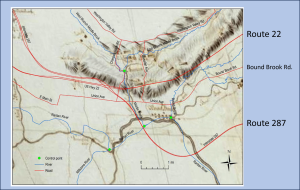
Historic Map of Middlebrook encampments by W. Scull, 1779, annotated with modern highways by Monmouth University student Michael Brown, 2020, in “Retracing the Middlebrook Encampments of the Revolutionary War: A Cartographic Analysis.
Following a series of skirmishes over food and other provisions in June 1777, the British General William Howe marched 18,000 troops toward Bound Brook to draw out Washington’s army from the safety of the hills to fight them on the open plains. When Washington refused to take the bait, “it signified that Howe was no longer able to occupy New Jersey. The battle for New Jersey had been won by the Continental Army,” Beck said.
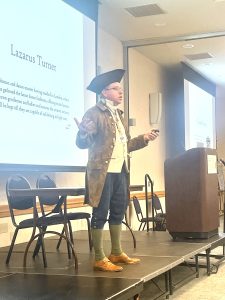
David Lang describes the Battle of Bound Brook.
Symposium organizers have announced a $5,000 prize for a paper based on “original research on the Middlebrook Spring Encampment, the Middlebrook Cantonment, or other aspects of the war in the Somerset County or central New Jersey area. With a deadline of December 31, 2025, the prize is funded by the generous support of the Heritage Trail, the Friends of Jacobus Vanderveer House, and anonymous donors. Additional information is available here.
At the recent symposium, historian Larry Kidder gave a presentation on the New Jersey militia who served their communities during the American Revolution by helping to keep the peace. He explained that the militia were not trained and equipped to fight a revolution, yet many of them played important roles, particularly during the Forage War of early 1777 across Central Jersey.
Historian William Welsch described the evolution of the Continental Army from a state of disarray at Morristown in January 1777, into a professional and better organized army at Middlebrook, under the direction of General George Washington.
David Lang of the Middlebrook Theatrical Society and former Heritage Trail board member gave his presentation in the uniform of a Revolutionary soldier while displaying his own annotated maps illustrating how the Battle of Bound Brook unfolded in April 1777. Mr. Lang described how Hessian soldiers under contract with the British captured Bound Brook for a few hours, capturing prisoners, intelligence, cannon, food, and other provisions before retreating. A key engagement in the Forage War, the plunder of Bound Brook directly led to Washington’s strategic decision to encamp at Middlebrook following the battle that spring.
Dressed as a Hessian jaeger fighting for the British, Dan McCarthy also reported on the Battle of Bound Brook from the perspective of the Hessians, relying on the diary of Johann Ewald, the Hessian commander, who planned and directed the attack on April 13, 1777.
The symposium was opened by Somerset County Commissioner Melonie Marano who described the county’s plan for preparing for the 250th anniversary of the United States next year. Plans include the creation of a park on the site of the Battle of Bound Brook, and improvements to the county’s Washington Valley Park where some of the Middlebrook encampment occurred. The county recently expanded the park to include a lookout where General Washington could keep a watch on British movements in the valley below, as portrayed in the photo at the top of this article.
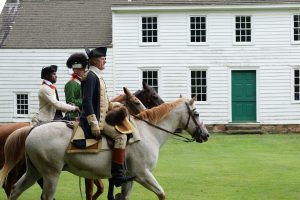
Reenactors on horseback at the Wallace House, Washington’s headquarters during Middlebrook.
Next year, historians and history buffs will again gather at Raritan Valley Community College on March 21, 2026, from 9 AM to 3:30 PM. to explore the importance and legacy of the two Middlebrook encampments, when thousands of American troops and leading generals dominated the New Jersey battle zone by holding the high ground of the Watchung Mountain range.
The Middlebrook Symposia are funded, in part, by the Somerset County Cultural and Heritage Commission, a partner of the New Jersey Historical Commission. The series was developed and organized through the joint efforts of several local historical organizations including the Heritage Trail Association, Inc., Friends of Abraham Staats House, Friends of the Jacobus Vanderveer House, Somerset County Historical Society, Wallace House and Old Dutch Parsonage Association, Friends of Bridgewater History, Wallace House State Historic Site, Washington Campground Association, and New Jersey Society, Sons of the American Revolution.
